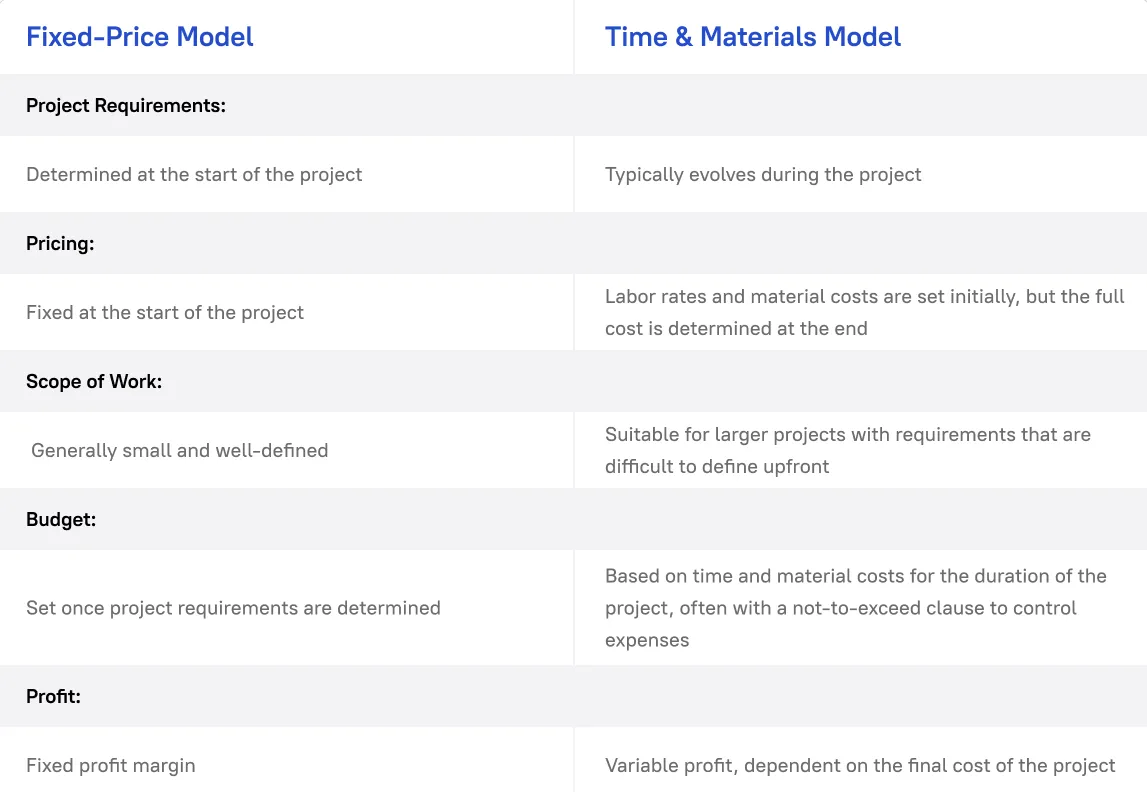
The right pricing model is very important to achieve the goals of your software development project. It provides a sound foundation for success when aligned with the complexity and objectives of your endeavor. The fixed pricing model brings predictability in costs and pre-defined scopes. The Time & Materials model offers unparalleled flexibility and transparency, allowing dynamic adjustments as the project evolves.
This blog post discusses the advantages and considerations of the Fixed Price model vs Time and Material and why we choose Time and Materials when developing software projects. It also shows how it can enable teams to deliver high-quality results without rigid limitations.
Stfalcon is the place where your ideas are transformed into robust and quality solutions. We provide solutions for startup - to enterprise-level businesses, including CRM development, web-based solutions, and iOS and Android app development.
Comparing Fixed Price and Time & Materials

The two most common models Fixed Price vs Time and Materials, each having advantages and limitations that fit the diverse requirements of a project.
Right Model Selection
Project attributes will drive the decision between Fixed Price and T&M:
- Scope clarity: Fixed Price fits well with clear boundaries; T&M fits ambiguous or inconstant needs.
- Budgetary constraints: Fixed-price means there is no uncertainty of cost. It secures cost predictability because T&M provides value with progressive betterment.
- Time to deliver: Fixed Price almost always has a stricter time constraint, while T&M affords greater flexibility in delivery dates.
Understanding the difference between fixed price and time and material ensures the approach aligns with project goals, ultimately driving success.
Want a web app that does more?
Let's build a solution that's smart, sleek, and powerful.
Alina
Client Manager

Fixed Price Model: Definition, Features, Advantages and Drawbacks
The fixed pricing model makes sense for projects when the scope is well understood - usually because the client has clearly described terms of reference (TOR) and project vision. Understanding the pros and cons of a fixed-price contract is essential when considering whether to use one for a project.
Key Features of the Fixed Price Model
- Pre-Approved Budget. The total cost is determined and agreed upon at the outset, providing financial certainty for both the client and the service provider. As long as the project adheres to the terms of the original agreement, there are no surprises in costs.
- Fixed Work Scope. The deliverables in the contract, from functionality to design, are explicitly agreed upon. This ensures all parties involved have the same understanding, leaving no room for misunderstandings.
- Defined Deadline. The timeline for completion is locked in at the beginning. This helps the project adhere to a strict schedule, which results in on-time completion.
- No Mid-Project Changes. Once the contract is signed, changes in the scope, budget, or deadline cannot be accommodated without formal renegotiation. Stability makes project management more manageable for the provider, with fewer risks.
- Suitability for Predictable Projects. This model works well for simple or repetitive projects whose requirements, like standard website builds, application development, or feature enhancement, would not change much.
- The fixed-price model provides clarity and predictability but can be insufficiently flexible. Therefore, planning and estimating costs before the project starts is crucial.
Advantages
- Fixed Costs. The client benefits from cost certainty; the outsourcing company cannot charge extra fees even if the development requires more time than estimated.
- Predictability. The project plan is well-defined, given a set release date and total cost.
- Ease of Monitoring. With a fixed budget and timeline, clients can easily monitor the progress and ensure that tasks are completed as scheduled without getting deeply involved in the development process.
Drawbacks
- Inflexibility. The contract is hard to change for new requirements or changes in the market; this will usually be done by signing the addenda.
- Lengthy Planning. The requirements are extensively discussed and analyzed in detail, significantly increasing the length of the planning period.
- Risk of Overpayment. If the estimates are too conservative and the team finishes early, the clients will have paid more than the value of the delivered work.
Time and Materials (T&M) Model: Definition, Features, Advantages and Drawbacks

Don’t be confused by the word «Time» in this pricing model. A Time and Materials model doesn’t mean that you simply pay for the developer’s time. Contract T&M assumes payment based on the work’s performance. If you want to go into more detail, here’s how it works.
Features of the T&M Model
- The Project is broken down into tasks, each of which will be separately estimated so you can add or modify anything during project development.
- The team will provide an up-front estimate for the total project, but this approximate figure will likely change - either up or down - as requirements are clarified and developed. At the outset of the project, a budget benchmark will be set to help guide planning and expectations;
- The T&M model offers task-based estimation by multiplying developers' hourly rates. After an estimate is given, you can review and approve costs before work can begin for complete transparency and flexibility.
Advantages of the T&M Model
- Flexibility in Scope. The other most significant advantage T&M brings is that for every new feature and change, the development team can easily accommodate it at any point in time without having to renegotiate the contract terms. This makes it the best fit for dynamic projects with requirements that will change over time.
- Better Control Over Development. This pricing model offers clients enhanced control over the development process by providing regular updates on progress. This transparency allows clients to monitor the project's direction and make informed decisions. If new requirements arise, adjustments can be made quickly without the limitations of a fixed scope. For instance, if a critical new feature becomes necessary, it can be implemented into the project seamlessly, ensuring the end product evolves in line with the client’s changing needs.
- Efficient Resource Allocation. The team size and composition can be adjusted dynamically throughout the project, offering greater flexibility to meet evolving requirements. As the project progresses, you can scale the team up or down based on workload demands and shifting priorities. This flexibility ensures that resources are allocated efficiently, whether it's adding more developers to meet tight deadlines or reducing the team size during slower phases to optimize costs. Additionally, you can tailor the skill set of the team to address specific challenges, ensuring that the right expertise is always available when needed.
- Transparent Budgeting. With T&M, the client is charged for actual hours developers work; hence, they can keep track of costs as they build up. The transparency in resource use lets clients monitor how resources are being used and adjust the project scope if needed.
- Faster project implementation. With T&M, teams can work iteratively, speeding up the whole process and delivering functional milestones faster - a benefit most appreciated in projects with changing or very tight requirements.
- Visible Progress. The client is constantly updated on the project's progress, and there are tangible results after each stage. Visibility helps manage expectations and allows for early identification of potential problems or areas needing refinement.
Drawbacks of the T&M Model
- Active Customer Participation Required. For the Time and Materials model to realize all its benefits, clients must be actively involved during the development process. In other words, regular feedback is given, progress is reviewed, and decisions are made at the required time. Project success depends upon the commitment shown by the client in communication and collaboration.
The T&M disadvantage is additional communication with the company. However, this may be a plus — when discussing details, you always know at what stage your project is, where it moves, and may add improvements or changes to it.
Why We Recommend Choosing The Time And Materials Model
At Stfalcon, T&M is the primary choice for delivering high-quality software solutions. This works well for projects where flexibility, iterative development, and close interaction with our customers are needed.
- Ideal for large and complex solutions. T&M has become the de facto model for large-scale projects like complex logistics systems, CRMs, and mobile applications. Such a project usually has changing requirements and can use the flexibility to change as the scope clears up during development.
- Supports Continuous Adjustments and Improvements. T&M works very well with Agile methodologies, allowing continuous adjustments and refinements throughout the project life cycle. This adaptability ensures that the final product will meet and exceed client expectations.
- High-Quality Deliverables. Developers focus on performance and functionality, not just meeting a rigid predefined contract. Continuous testing and improvements lead to a better end product.
- Faster Project Kickoff. There is no need to spend excessive time on detailed pre-planning and requirement documentation. Development can begin quickly, while refinements are made along the way.
- Efficient Resource Management. The team size and composition can be adjusted dynamically based on project needs. You can scale up or down depending on workload and budget constraints.
- Better Control Over Development Process. Clients have regular updates on progress and can adjust priorities as needed. No restrictions to a fixed scope—if a new feature becomes essential, it can be added seamlessly.
At Stfalcon, we deliver scalable solutions with transparency in mind and build strong relationships with clients, which allows us to bring impactful results that align with the client's vision.
We develop complex solutions for large and medium-sized businesses and startups and complex services for logistics, CRM systems, mobile applications, etc. During more than 15 years of practice, we have seen that the customer rarely has an accurate idea of all the required functionality at the start of a large project's development. With the step-by-step project development, we, together with the customer, delve deeper into the project’s needs. This is how new ideas and improvements appear. The time and Material model is very convenient in this case — you can make adjustments directly during the work.
Insights and Recommendations Working on a Project with T&M Pricing Model
Recommendation of working on a project with the T&M pricing model
The steps below allow the client to benefit from using a T&M contract while maintaining control over their project.
1. Set Clearly Defined Initial Goals. Even if the full scope is not yet defined, setting priorities and objectives right from the beginning will give a clear direction for the project.
2. Establish a Regular Communication Process. Ensure open and transparent communication with the service provider to be on the same page concerning progress, costs, and expectations.
3. Track Costs and Progress. Request regular updates on time, resource utilization, and expenses to maintain a project goal on the budget.
4. Change Management. Have a structured approach in reviewing, approving, and documenting scope changes so that the changes are managed effectively and predictably.
5. Build Trust and Partnership. Build a strong partnership with your vendor so that the project will proceed in a manner that meets your expectations and objectives.
6. Regular Review Session. Periodically review the project's progress versus the objectives to make informed decisions on shifting priorities or new directions.
By following these steps, you can harness the flexibility of the T&M model and still realize efficient and effective results.
But, you may go for a fixed-price contract if you have a small project and are 100% sure you will not need significant improvements.
Conclusion
Choosing between time and material vs fixed price needs careful consideration. It creates a foundation for success when the model is aligned with your endeavor's complexity and objectives. Project pricing structure choice is a very critical decision, so you should know the differences between Time and Materials vs fixed-price models, as each has different advantages depending on the scope and complexity of the project. From our experience, we guide customers toward the most appropriate contract type for their specific needs.
Be it working with startups in the uncertainties of the market, medium-sized companies whose needs are still changing, or large, established firms with clear goals, we carefully weigh each situation to advise on the best model.
Stfalcon strives to balance flexibility and anticipation to ensure that projects end with desired results efficiently and effectively.
Would you like to order the development of CRM, web-based solutions, iOS and Android application development? Сontact us, and let’s bring your creative ideas to reality!
FAQs about Fixed Price vs Time and Materials
Can T&M work for startups or small businesses?
T&M contracts are designed for dynamic scopes, allowing for flexibility and constant change. The T&M model applies in cases where the project requirements are unclear at the outset or are likely to change substantially. This describes almost perfectly the state in which most startups find themselves. They usually start with a vision, or at least with some rough idea, and most have to build up their assumptions and refine their to-do activities as they go along, learning more about their market, their users, and the challenges ahead.
Can T&M projects have deadlines?
Time & Material provides flexibility, as there are no strict deadlines like in other collaboration models. The projects are broken down into shorter phases, usually 2-4 weeks, which are manageable and easy to adjust. Each phase has a specific task or goal in mind. Once each task is completed, you will receive a detailed report to review the results and give feedback.
What are the best practices for managing scope creep in a T&M project?
Scope management means that your goals are achieved at a predictable cost. With clear objectives, detailed requirements, and defined scope, you will know precisely what's in and out, reducing the possibility of unmet expectations. Structured change control means you can approve changes only when necessary and aligned with your priorities. You will get regular updates on progress, resource usage, and costs; hence, you will be in a position to be more in control of the project. You can also ensure that your project remains focused, avoiding undue scope creep, with stakeholder sign-offs and controlled access to the scope documents to deliver effective and cost-efficient results.
How to manage stakeholders' expectations in a T&M model project?
The Time and Materials billing model means you can expect flexibility and transparency in your projects, understand the needs, and evolve with those needs. In this model, solutions are bespoke, providing advantages for scope and priorities to adapt to any changes in your requirements. That guarantees you receive updates on the usual progress of tasks and costs incurred. The T&M model is all about collaboration, which will keep you actively involved in the decision-making process and thus enable you to provide feedback and steer the project direction as it unfolds. With a strong emphasis on transparency and accountability, the methodology keeps efforts aligned with your expectations and project constraints, allowing for changes that meet new business demands. That makes the T&M model especially good for dynamic projects, where adaptability and ongoing input are crucial to success.



